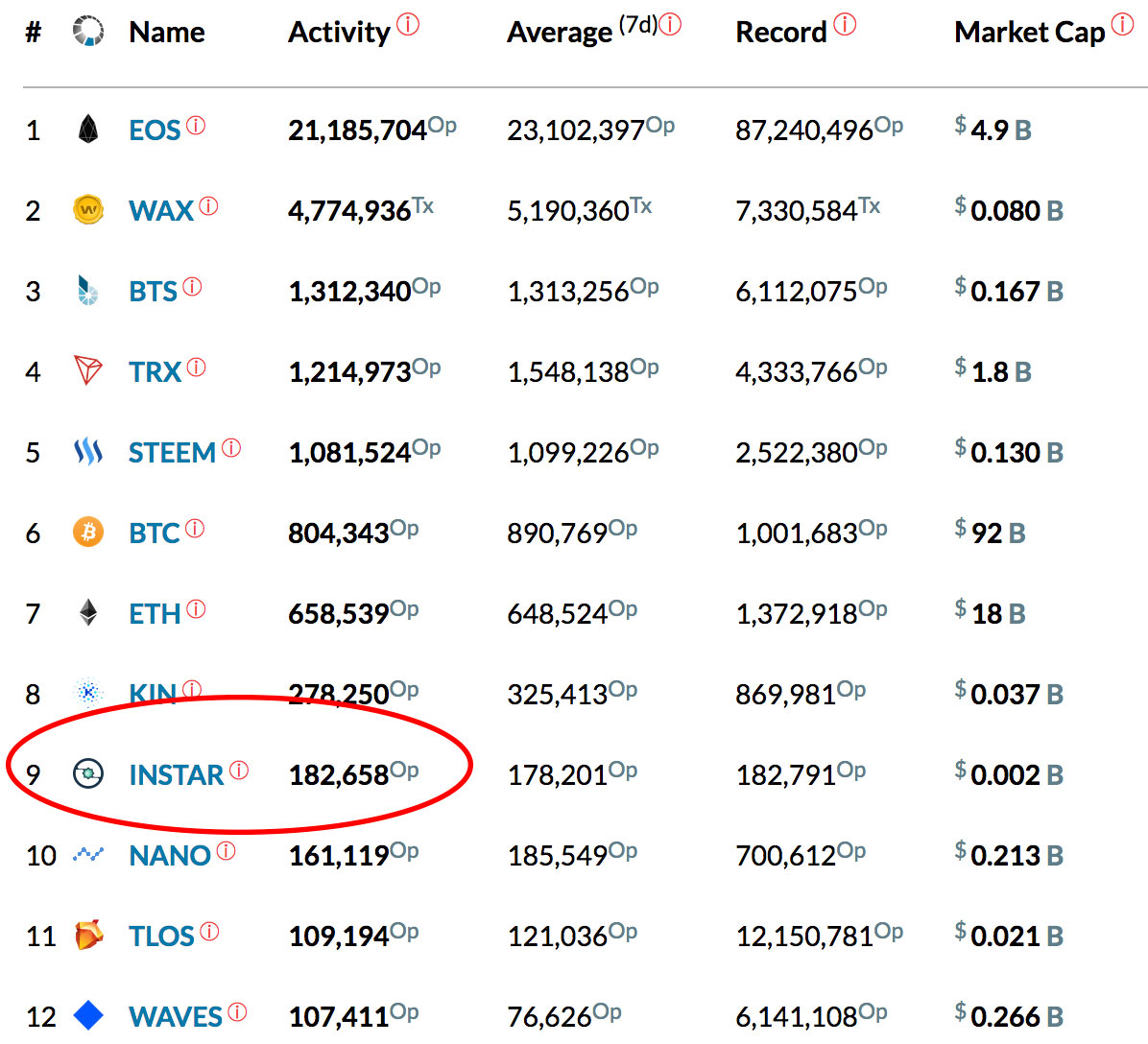In the world of dApp activity, many blockchains have been competing for a long time to onboard users and maintain them. The majority of these projects have realized that gaining and maintaining users is a very tough thing to do. However, there is one project that is trailblazing ahead of its competition and has already amassed a large user base of over 250,000 users.
The INSTAR blockchain, a project provided by the Insights Network, has recently been listed on Block’tivity, and the amount of daily operations that this little known project facilitates is truly staggering;

This little-known cryptocurrency project is currently in public beta, but has already achieved over 180,000 operations per day. This makes this very young project the 9th-most active blockchain, putting it ahead of well-known projects such as WAVES, NANO, and Bitcoin Cash.
The majority of the operations come from the InstarWallet.com, the first application to be released on the INSTAR blockchain. Furthermore, the wallet has already signed up over 250,000 approved members, with over 100,000 being KYC compliant, making it one of the largest blockchain applications based on the number of users.
Creating a Decentralized Data Exchange
The Insight Network, co-founded by Brian Gallagher (CEO) and Darwin Lo (CTO), aims to create a trustless and decentralized data exchange. They believe that the original data brokerage industry is broken, as over $200 billion worth of data is bought and sold in a nontransparent and invasive manner. The majority of users are unaware that their data profiles are being sold, and therefore have no say in what happens to their data.
The Insight Network aims to put an end to this underhanded data brokerage industry by creating a data exchange that combines Secure Multiparty Computation (SMPC) and blockchain to enforce the fair exchange of data and payments.
The team were the first organization on record to publish a whitepaper and publically state that they will use the EOS Open Source Software as the underlying foundation to the Insight Network Data Exchange. This was a risky move on the co-founders’ part, as at the time EOS had not even shipped their product.
In September 2017, The co-founders took their first call with the EOS development relations team and were completely blown away by their seriousness and commitment after just an hour-long conversation. By October 9, 2017, the team released their first version of their whitepaper, which detailed how the EOS blockchain would be combined with SMCP to create the first privacy-preserving and user-controlled data exchange.
“We had read the EOS whitepaper, the design of their blockchain absolutely fit our needs… Blockchain accounts we could assign to verified individuals who participate in the data exchange, near zero transaction cost that supports global micropayments to participants, and a promise of high transaction throughput that could scale to millions of users. The big bet for us was, do we put our project proposal behind another project that hasn’t shipped their product yet? The bet completely paid off – EOS shipped their product on time and with technical precision. The $0.05 micropayments made by our data exchange smart contracts simply wouldn’t have worked on Ethereum.”
Biggest News Yet
In a worldwide exclusive announcement, the INSTAR team have stated that after the start of their token migration, they will release a newly updated whitepaper to describe how Block Producer voting will work.
Perhaps more importantly, the team will also showcase new additions to their long-term roadmap. The new addition will be an EOS and INSTAR mainnet decentralized exchange collaboration. This collaboration will allow the KYC-compliant user base to directly swap INSTAR tokens that have been earned for EOS tokens, thus driving EOS adoption further.
The Insight Network team will also offer SMPC nodes, which will allow developers to focus on privacy-preserving applications and deploy them on the INSTAR blockchain as dApps. The Insight Network team have secured an infinite, perpetual licence from their SMPC experts, Peter Frandsen, Kurt Nielsen, and Jesper Nielsen, who have been working for the past decade to deliver.
The Insight Network team believe this to be a huge deal, as the majority of their user base are fresh to cryptocurrency and blockchain technology.
“We are seeing a different type of demographic entering our platform – users who are new to blockchain technology earning their first ever cryptocurrency. Our mission from day 1 has been to use our platform to fuel widespread crypto adoption to a new audience of earners – rather than cater to and compete for the audience the cryptocurrency industry has seen to date, which is mostly an investor/speculator community.”
The Insight Network team continued, stating that they have seen a great uptick in the number of Turkish users signing up and being referred by friends. This is particularly significant due to the fact that their currency, the Turkish Lira, has been collapsing over the past year, causing users to seek a better alternative.
“Just the other day, I noticed a huge surge in Turkish signups and participation the day the value of the Turkish Lira dropped over ten percent. If you check my Twitter, I went on record saying the combination of these two events is correlated, and this was very bullish for Bitcoin. Less than 24 hours later, we saw the 30% rise in the price of bitcoin.”
The Token Migration
The public beta period for the INSTAREOS blockchain, which runs its own block producer network, will end in May. The Insight Network team is preparing to freeze existing ERC-20 INSTAR token contracts while simultaneously opening token migration contracts on MyEtherWallet at the end of May. ERC-20 token holders will have the option to migrate their tokens using the Greymass desktop wallet or InstarWallet.com.
In an exclusive InvestInBlockchain announcement, the Insight Network team have told us that in an attempt to spur further EOS adoption, that they will be open-sourcing the migration software they built so that any dApps on Ethereum who are considering moving to the EOS blockchain can do so easily by utilizing the open-source code built by Insight’s network.
Once 50% or more of the INSTAR token supply has been successfully migrated, INSTAR token holders can vote on their selected block producer network.

